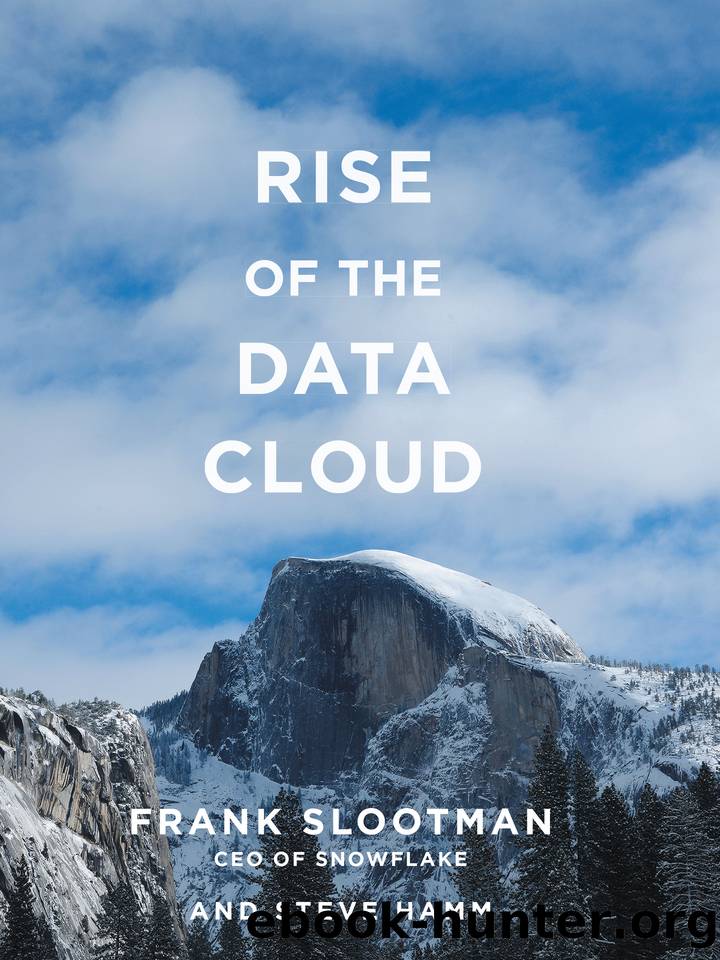Rise of the Data Cloud by Hamm Steve & Slootman Frank

Author:Hamm, Steve & Slootman, Frank [Hamm, Steve]
Language: eng
Format: epub
Publisher: Snowflake
Published: 2020-12-15T16:00:00+00:00
Use cases for data sharing
Snowflake has identified a handful of typical models for sharing data. Justin calls these âsharesonasââriffing on the way consumer marketing firms create personas to segment markets. In each case, the cloud and sharing capabilities like those Snowflake offers are essential building blocks.
The Silo Buster: Expedia Group fits in this category. Departments and business units within a large enterprise typically collect data for their own use and stash it in their own databases. Those are data silos. A cloud data warehouse makes it easy for those parts of an enterprise to share data with one another. Frequently, separate organizations within an enterprise set up Snowflake accounts and begin storing data thereâthen they discover that sister organizations have done the same. Itâs a cinch to open doors between them so they can begin sharing more robustly.
The Connected Enterprise: Every business has an ecosystem of suppliers, partners, customers, and others that it cooperates with to get things done. The outsourcing trend has made such linkages even more important. With open communications and coordination, these ecosystems can operate like virtual enterprises. Cloud data sharing can make them even more nimble and responsive. Sharing between enterprises is easier, faster, and more secure. By providing real-time data transparency to business partners, enterprises can deepen relationships, build trust, and collaborate with others more effectively.
An example is Rakuten Rewards, which runs the largest consumer loyalty program in the United States. Shoppers earn cash back for purchasing from participating merchants. Rakuten Rewards uses data sharing within the Snowflake cloud data platform to allow outside firms to analyze its data. That way, the company can get input from people with advanced expertise for special projects, without having to hire high-priced experts for a temporary need. Rakuten Rewards is also a silo buster in its own right, using data sharing within the larger Rakuten company to dramatically enhance the power of the Rakuten Rewards datasets.
Data as a Service: The market for data has been booming with the recognition that enterprises can deepen their understanding of their markets and shift economic trends by combining third-party data with their own. A growing number of companies are in the business of selling, consolidating, brokering, syndicating and enriching data. A cloud data warehouse enables these companies to share data with customers in a more granular and secure way.
Some advertising technology firms provide the whole array of digital advertising services for clientsâincluding troves of data that helps them identify and reach consumers. These companies also typically provide analytics services and advice to help clients use the data to plan and manage campaigns and measure their performance.
The Data Super-Consumer: Enterprises in a number of industries, especially financial services and consumer packaged goods, have become ravenous users of data from third-party sources. They want context. Rather than shopping externally for data and importing it into their databases the old-fashioned (and inefficient) way, they set up private cloud data exchanges and invite their data providers to interact with them there. The buyer calls the shots.
Say a hedge fund purchases information from thousands of sources.
Download
This site does not store any files on its server. We only index and link to content provided by other sites. Please contact the content providers to delete copyright contents if any and email us, we'll remove relevant links or contents immediately.
Grails in Action by Glen Smith Peter Ledbrook(9163)
Sass and Compass in Action by Wynn Netherland Nathan Weizenbaum Chris Eppstein Brandon Mathis(8808)
Azure Containers Explained by Wesley Haakman & Richard Hooper(7440)
Configuring Windows Server Hybrid Advanced Services Exam Ref AZ-801 by Chris Gill(7431)
Kotlin in Action by Dmitry Jemerov(7263)
Running Windows Containers on AWS by Marcio Morales(6980)
Microsoft 365 Identity and Services Exam Guide MS-100 by Aaron Guilmette(5398)
Microsoft Cybersecurity Architect Exam Ref SC-100 by Dwayne Natwick(5208)
Combating Crime on the Dark Web by Nearchos Nearchou(4978)
The Ruby Workshop by Akshat Paul Peter Philips Dániel Szabó and Cheyne Wallace(4667)
Management Strategies for the Cloud Revolution: How Cloud Computing Is Transforming Business and Why You Can't Afford to Be Left Behind by Charles Babcock(4527)
Python for Security and Networking - Third Edition by José Manuel Ortega(4232)
The Age of Surveillance Capitalism by Shoshana Zuboff(4209)
Learn Wireshark by Lisa Bock(4114)
The Ultimate Docker Container Book by Schenker Gabriel N.;(3886)
Learn Windows PowerShell in a Month of Lunches by Don Jones(3681)
DevSecOps in Practice with VMware Tanzu by Parth Pandit & Robert Hardt(3565)
Windows Ransomware Detection and Protection by Marius Sandbu(3540)
Blockchain Basics by Daniel Drescher(3507)
